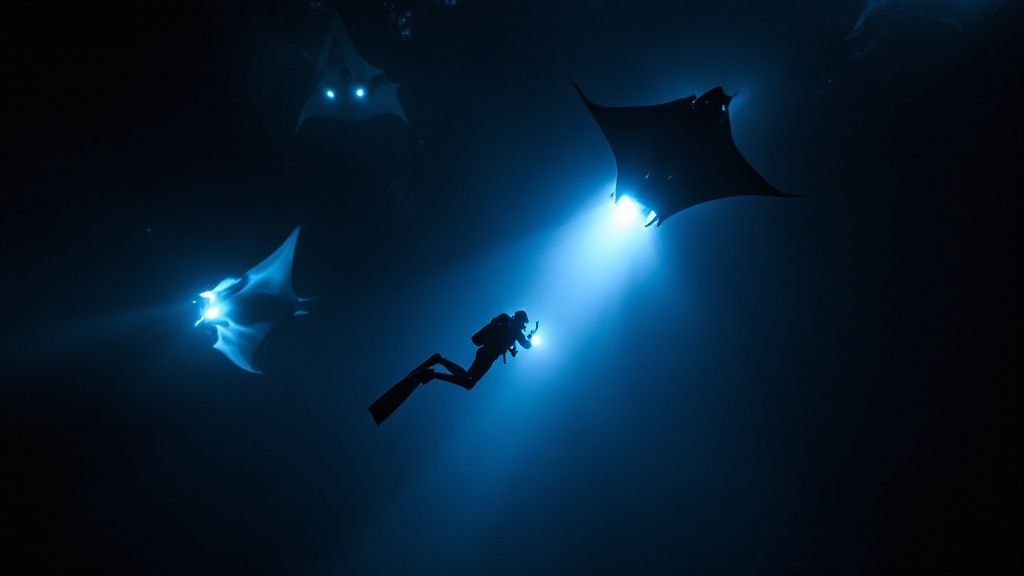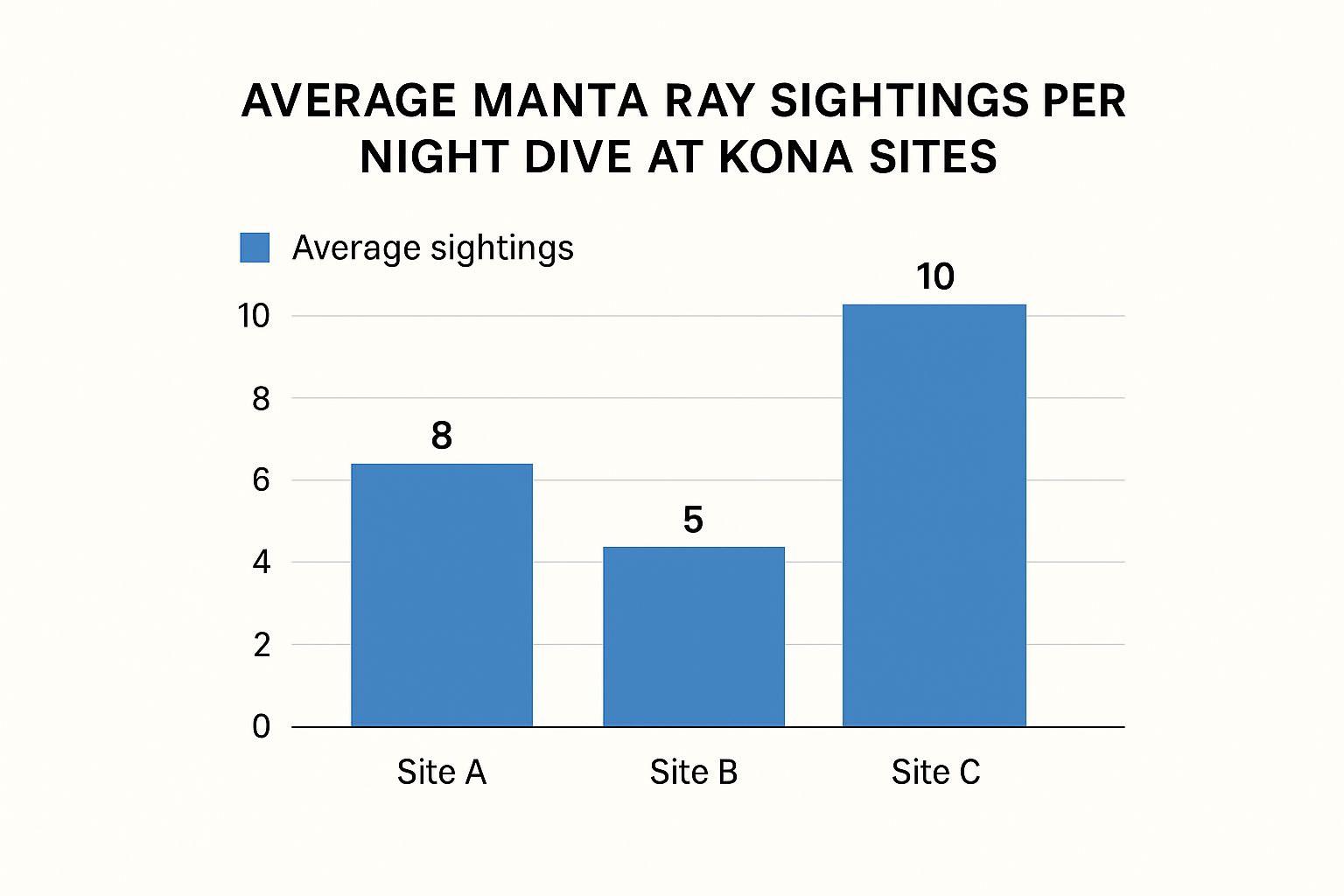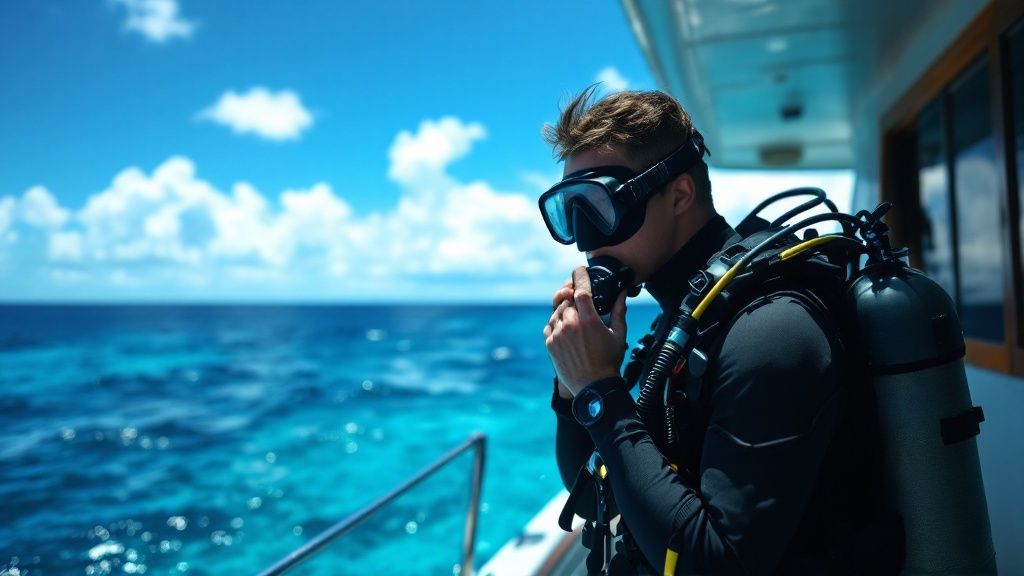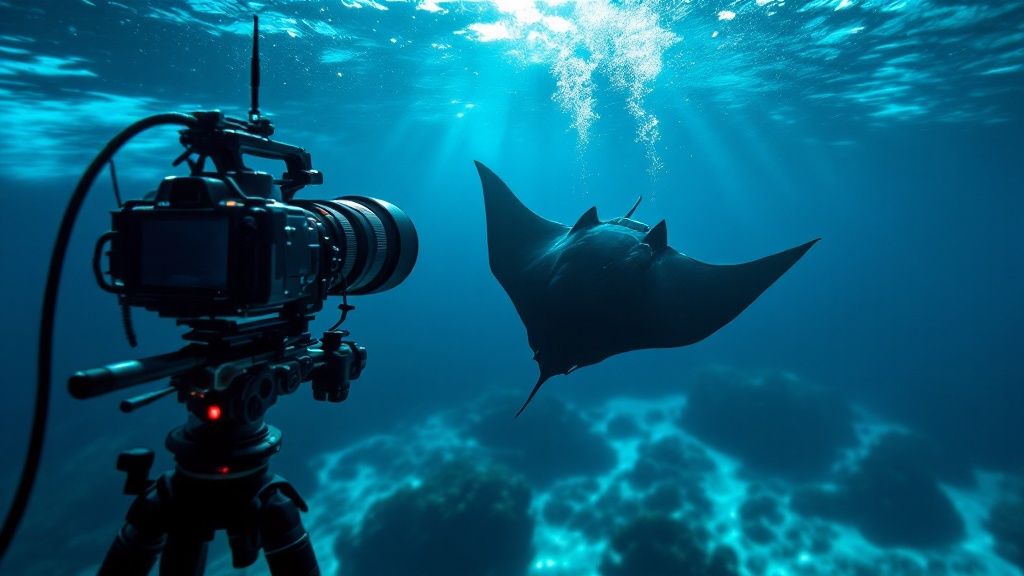The Magic Behind Kona's World-Famous Manta Ray Dives
What makes a manta ray dive in Kona so special? It's the unique combination of several factors that create a truly magical experience. The warm, clear waters of the Pacific offer exceptional visibility, even at night. This clarity is essential for observing these gentle giants. Combined with Kona's unique underwater topography, the stage is set for an unforgettable encounter.
The volcanic slopes of the Big Island also play a vital role. They create nutrient-rich upwellings that support a thriving plankton population. This abundance of plankton, the manta ray's primary food source, attracts these magnificent creatures to specific locations. Sites like Manta Village and Manta Heaven are known for their consistent plankton blooms, creating predictable feeding grounds. This reliability has made Kona a global hotspot for manta ray dives.

This predictable feast is amplified by the clever use of dive lights. Strategically positioned by dive operators, these lights attract even more plankton. This creates a concentrated food source, drawing the manta rays closer to the surface. Divers and snorkelers can then witness their graceful feeding behaviors up close, often within just a few feet. This orchestrated "plankton buffet" is a key element of the Kona manta ray dive experience.
Kona, Hawaii, is renowned for its reliable manta ray sightings, especially at Manta Village and Manta Heaven. Detailed records from 2009 to 2014 tracked individual mantas, their condition, and locations. These records helped understand the mantas' home range and predict when higher numbers might be seen. The data, collected during night dives conducted six to seven nights a week, showcases the consistent presence of these creatures. For example, statistics from 2013 highlight the total number of individual mantas seen each month, offering insights into their seasonal behavior and habitat preferences. Find more detailed statistics here: Manta Ray Statistics.
The Role of Conservation and Responsible Tourism
The magic of the Kona manta ray dive wouldn't be possible without careful stewardship. Thoughtful regulations and community efforts protect this fragile ecosystem. Responsible dive operators prioritize sustainable practices, using eco-friendly lights and adhering to strict interaction guidelines. This ensures the manta rays remain undisturbed and the experience stays sustainable for future generations. You might be interested in: Learn more about the manta ray dive experience in Kona.
Why Kona Stands Out
The combination of clear water, abundant plankton, strategic lighting, and responsible tourism creates a unique experience. This is what truly sets the Kona manta ray dive apart, transforming an ordinary night dive into an unforgettable underwater ballet.
Kona's Premier Manta Sites: Where Ocean Magic Happens
Kona, Hawaii, is a diver's paradise, offering more than just picturesque beaches. Beneath the surface lies a world of wonder, where manta ray encounters aren't just a possibility, they're a nightly spectacle. This predictable magic is thanks to Kona's unique underwater topography, currents, and nutrient-rich waters, teeming with the plankton that mantas love. This section delves into Kona's best manta ray dive sites, highlighting what makes each one special.
Unveiling Kona's Manta Hotspots
For those searching for the perfect "manta dive kona", two names consistently rise to the top: Manta Village and Garden Eel Cove (Manta Heaven). Manta Village, nestled in Keauhou Bay, is famous for its calm, shallow waters and near-guaranteed sightings. The bay’s unique shape traps plankton, creating a reliable feeding ground that draws mantas in night after night.
North of Kona International Airport lies Garden Eel Cove, with its sandy bottom and thriving garden eels, adding to the rich biodiversity. Both locations provide breathtaking opportunities to observe these gentle giants up close.
The infographic below visualizes average manta ray sightings per night dive at three different Kona locations.

As the infographic shows, Site C boasts significantly more sightings on average than Sites A or B, emphasizing how location choice impacts your "manta dive kona" experience. Beyond these popular spots, however, quieter locations offer more intimate encounters, away from the crowds. These hidden gems may require a little extra research and potentially a longer boat trip, but the reward is a truly unique experience.
Choosing Your Ideal Site
Selecting the right dive site depends on several factors, including your diving experience, photography aspirations, and even your preference for boat rides. Manta Village, with its easy access and calm conditions, is often the go-to for beginners. More seasoned divers might favor Garden Eel Cove's deeper waters and the chance to see larger groups of mantas.
Seasonal changes also play a role. Summer usually brings calmer seas and heightened manta activity, while other seasons offer unique viewing opportunities with potentially fewer people. Kona boasts an estimated 450 manta rays, each with average wingspans of 12 feet or more, cementing its status as a manta ray haven. This high population density is a testament to the area's vibrant marine ecosystem, making Kona world-renowned for manta ray dives. Learn more about manta ray populations in Kona.
Beyond the Famous Two: Exploring Hidden Gems
While Manta Village and Garden Eel Cove are justly famous, venturing to less-traveled dive sites can bring unique rewards. Some spots along the Kohala Coast, for example, offer a more intimate experience with fewer divers in the water. This translates to a quieter, more personalized encounter with these gentle giants.
To help divers select the best site, the following table compares Kona's top manta ray dive locations.
Kona's Top Manta Ray Dive Sites Comparison
A detailed comparison of the primary manta ray dive locations in Kona, helping divers choose the site that best matches their experience level and preferences
| Dive Site | Success Rate | Average Depth | Best Time | Experience Level | Notable Features |
|---|---|---|---|---|---|
| Manta Village (Keauhou Bay) | Very High | 15-30 ft | Year-round, best in summer | Beginner | Calm, shallow waters, easy access |
| Garden Eel Cove (Manta Heaven) | High | 30-40 ft | Year-round, best in summer | Intermediate | Deeper waters, potential for larger manta gatherings |
| Kohala Coast Sites | Moderate | Varies | Varies | Intermediate/Advanced | More secluded, intimate experiences |
As this table highlights, each site caters to different preferences and experience levels. Choosing the right site means considering your priorities, but regardless of your choice, a "manta dive kona" experience is sure to be unforgettable. These quieter spots might require more research and longer boat trips, but the payoff can be a remarkable, uncrowded manta ray encounter.
Inside a Manta Dive Kona Experience: Moment by Moment
The Kona manta ray night dive is more than just a nighttime ocean dip; it's a carefully planned event designed for optimal interaction with these gentle giants. From the pre-dive briefing to the post-dive excitement, every part adds to the magic. Let's explore what awaits you during those captivating 45-60 minutes underwater.
Setting the Stage: The Pre-Dive Briefing
Your Kona manta ray adventure starts with a thorough briefing. Here, your expert guide details the dive plan, highlighting safety procedures and responsible manta ray interaction. They'll stress the importance of keeping a safe distance and avoiding any contact with the mantas, ensuring both your safety and the well-being of these amazing animals. The briefing also covers hand signals and other underwater communication, guaranteeing a seamless dive. You'll even learn how the dive lights attract plankton, the manta rays' main food source.

The Descent: Entering the Manta's World
After the briefing, you'll descend into the dark depths, usually to about 30-40 feet. Once settled on the ocean floor (typically sand or rock), your guide positions the dive lights. This is where the true spectacle unfolds. The lights draw in plankton, setting the stage for a remarkable display of manta ray feeding.
The Ballet Begins: Manta Ray Feeding Frenzy
As the plankton gathers, the manta rays emerge, often appearing from the darkness like phantoms. They move gracefully through the illuminated water, performing captivating barrel rolls and loops as they eat. This is your opportunity to observe these magnificent creatures close-up, admiring their size and agility. Remember the briefing's focus on respectful observation; your stillness ensures the manta rays remain undisturbed. You might be interested in: Learn more in our article about two tank manta dive snorkel.
A Symphony of Light and Movement
The combination of light and movement creates a surreal underwater ballet. The manta rays, with wingspans sometimes reaching 12 feet or more, seem to dance in the light beams. Kona manta ray night dives offer an exceptional underwater experience with a high rate of manta ray sightings. On average, this rate is over 95%, though some sources estimate it to be around 85-90% based on the dive operator. This high success rate is thanks to consistent plankton blooms, particularly at sites like Manta Village. The average dive lasts 45-60 minutes, providing ample observation time. Find more insights about [manta ray sighting success rates] here: Jack's Diving Locker Manta Report.
The Ascent: Leaving the Magic Behind
As your dive ends, you'll slowly ascend, taking with you the memory of an incredible encounter. Back on the boat, post-dive conversations are filled with excitement and awe. The experience often leaves divers with a deep sense of wonder and a new appreciation for these ocean giants. This is the heart of a Kona manta dive—a unique mix of adventure, education, and underwater magic.
Preparing For Your Manta Dive Kona: Beyond The Basics
The difference between a good manta ray dive and a truly unforgettable one often hinges on preparation. Going beyond the usual advice, this section provides insights to maximize your comfort and enhance your manta ray encounter in Kona. Proper planning ensures you're not just observing, but actively participating in this underwater spectacle.
Optimizing Your Gear For Night Diving
The Kona manta dive occurs at night, necessitating specific gear choices. While a wetsuit is essential for warmth, its thickness makes a difference. A 3mm wetsuit offers sufficient insulation without restricting movement. A thicker wetsuit, for example, could limit your flexibility and hinder buoyancy control. Also, select a mask design that optimizes your field of vision. Low-profile masks with minimal frame obstruction will maximize your viewing area.
Precise buoyancy control is critical for both your enjoyment and the manta rays' well-being. Mastering your diving techniques helps prevent accidental contact with these graceful creatures. Think of buoyancy control like riding a bike: it requires practice, but becomes second nature, enabling you to navigate the underwater world with ease.
Capturing The Magic: Photography Tips
Underwater photographers seeking to capture these magnificent animals in low-light conditions need specialized knowledge. Key camera settings include a high ISO, a wide aperture, and a slow shutter speed. Finding the right balance between these settings is essential. For example, an excessively high ISO can introduce noise, while a shutter speed that's too slow can result in blurry images. Consulting experienced underwater photographers or exploring online tutorials can significantly improve your technique.
Addressing Common Concerns
Many divers worry about seasickness, particularly on night dives. Fortunately, effective remedies exist. Over-the-counter motion sickness medication, taken an hour before the dive, can mitigate symptoms. Acupressure wristbands offer a drug-free alternative. These bands apply pressure to specific wrist points, believed to relieve nausea.
Another common concern is the need for prescription masks. Several dive shops in Kona provide custom-made prescription masks, ensuring clear vision underwater without contact lenses. Addressing these concerns in advance contributes to a more relaxed and enjoyable dive.
The Importance of Mental Preparedness
Beyond physical and equipment preparation, mental readiness is vital for your manta dive experience in Kona. Realistic expectations are key. While Kona's waters boast frequent manta ray sightings, these animals are wild, and their behavior unpredictable. This understanding allows you to appreciate any encounter, from a fleeting glimpse to a spectacular feeding frenzy.
Visualizing the dive and practicing deep breathing exercises beforehand can help manage any anxiety about night diving. Mental preparation, coupled with proper gear and physical readiness, creates the perfect foundation for a truly memorable manta ray encounter. This comprehensive approach transforms a simple dive into a profoundly enriching experience.
Finding Your Perfect Manta Dive Kona Operator
Choosing the right manta ray dive operator in Kona can make or break your experience. With so many options available, it's essential to look beyond the surface and understand the nuances that distinguish a truly exceptional dive. This involves knowing the right questions to ask, recognizing signs of quality service, and ultimately, selecting an operator that aligns with your personal preferences.
Key Questions to Ask Potential Operators
Before booking your manta ray night dive, ask potential operators key questions to gauge their commitment to safety and customer satisfaction. For example, inquire about their group size limits. Smaller groups often lead to a more personalized experience and less crowded viewing conditions. Also, ask about the guides' experience and certification. A knowledgeable guide can significantly enrich your dive with insights into manta ray behavior and the marine environment. Want to learn more about diving with manta rays in Kona? Learn more about the manta ray dive experience in Kona.
- What type of dive boats do they use?: Larger boats offer more stability and comfort, while smaller boats may provide faster access to dive sites.
- What is their cancellation policy?: Understanding their policy on weather cancellations or unforeseen circumstances is crucial for planning.
- Do they offer any pre-dive briefings or educational materials?: A good pre-dive briefing ensures everyone is prepared and understands responsible manta ray interaction guidelines.
Indicators of Exceptional Operations
Beyond asking direct questions, look for subtle cues that indicate an operator's commitment to excellence. A commitment to sustainable practices, such as using eco-friendly lights and adhering to interaction guidelines, shows respect for the marine ecosystem. Being prepared for emergencies is also crucial. Check out resources like the Emergency Preparedness First Aid Kit for ideas on what to have handy. Clear and proactive communication before the dive, including detailed information about meeting locations, what to bring, and expectations, demonstrates professionalism and organization.
- High-quality equipment: Well-maintained gear, including wetsuits, masks, and snorkels, ensures a comfortable and safe dive.
- Positive customer reviews: Consistently positive reviews are a strong indicator of an operator's dedication to customer satisfaction.
- Experienced and knowledgeable staff: A passionate and knowledgeable team can greatly enhance your overall experience.
To help you choose the right manta ray dive operator, we've created a table summarizing key selection criteria.
The table below, "Manta Dive Operator Selection Criteria," provides a comprehensive breakdown of factors to consider when choosing a manta ray dive operator in Kona.
| Selection Criteria | Why It Matters | Questions to Ask | What to Look For |
|---|---|---|---|
| Group Size Limits | Less crowded viewing, more personalized attention | What is the maximum number of divers per guide? | Small groups (6-8 divers) |
| Guide Experience & Certification | Enhanced dive experience, insightful information | How long has the guide been diving with manta rays? What certifications do they hold? | Extensive experience, relevant certifications |
| Boat Type | Comfort and stability, access to dive sites | What type of boat do you use? | Larger, stable boats for comfort, smaller boats for quicker access |
| Cancellation Policy | Flexibility and peace of mind | What is your cancellation policy regarding weather or other unforeseen circumstances? | Clear and reasonable cancellation policy |
| Pre-dive Briefings & Education | Safety and responsible interaction | Do you provide a pre-dive briefing? Do you offer educational materials about manta rays? | Thorough briefing covering safety and interaction guidelines |
| Sustainable Practices | Respect for the marine environment | What sustainable practices do you employ? | Use of eco-friendly lights, adherence to strict interaction guidelines |
| Communication | Clarity and organization | What information will you provide before the dive? | Detailed information about meeting points, what to bring, and expectations |
| Equipment Quality | Comfort and safety | What is the condition of your dive equipment? | Well-maintained wetsuits, masks, and snorkels |
| Customer Reviews | Indicator of service quality | Can I see your customer reviews or testimonials? | Consistently positive reviews and feedback |
| Staff Knowledge & Passion | Enriched dive experience | How knowledgeable is your staff about manta rays and the local marine environment? | Passionate and knowledgeable team |
This table highlights key factors to consider, from group size and guide experience to sustainability and communication. By carefully evaluating these criteria, you can make an informed decision.
Understanding the Trade-offs: Budget vs. Premium
Balancing budget and quality is important. Budget-friendly operators may offer lower prices, but they might also have larger groups and less personalized attention. Premium operators often offer smaller groups, higher-quality equipment, and more experienced guides. While a premium experience can be more immersive, sometimes the added cost covers extra amenities rather than a significantly better manta ray encounter. Carefully consider your priorities and budget to find the best fit.
Making Your Decision: Choosing the Right Fit
Finding the ideal “manta dive Kona” operator involves thoughtful consideration. What are your top priorities: budget, group size, guide experience, or boat amenities? Researching different operators, reading reviews, and asking questions will help you find the perfect match. This careful selection ensures your “manta dive Kona” experience is truly exceptional.
Beyond the Dive: Supporting Manta Conservation in Kona
Your manta dive Kona experience offers more than just a personal memory. It provides a unique opportunity to contribute to the conservation of these incredible creatures. This section explores the connection between tourism, research, and conservation, highlighting how you can actively participate in protecting manta rays for generations to come.
Understanding the Importance of Manta Ray Research
When choosing a manta dive operator, researching their background is essential. A good place to start is their About Us page. Ongoing research is vital for understanding manta ray populations and behaviors. Identification programs, using the unique spot patterns on each manta's belly, have transformed our knowledge of these animals. These "underwater fingerprints" allow researchers to track individual mantas, monitor population size, and study their movements and social interactions. This information is the foundation of effective conservation strategies. For instance, by tracking manta ray movements, researchers can pinpoint critical habitats and migration routes, informing the establishment of marine protected areas.
Threats and Solutions: Protecting Kona's Manta Rays
Hawaii's manta rays face numerous threats, such as entanglement in fishing gear, habitat degradation, and the effects of climate change. Fortunately, innovative solutions are being implemented on a local level. For example, organizations are collaborating with fishers to create and promote modified fishing gear to reduce the risk of manta ray entanglement. Furthermore, community-based conservation programs educate locals about the importance of protecting these gentle giants. These programs highlight sustainable practices and promote responsible human-manta ray interactions.

Making a Difference: How Your Choices Matter
As a visitor, your decisions directly influence manta ray conservation outcomes. Choosing a responsible manta dive operator is the first crucial step. Look for operators prioritizing sustainable practices, such as using eco-friendly lights and adhering to strict interaction guidelines. They should also actively support research and conservation initiatives.
Be mindful of greenwashing, where operators make misleading environmental claims. Instead, choose operators transparent about their practices and actively involved in local conservation efforts. Your underwater behavior also matters. Maintaining a respectful distance, refraining from touching the mantas, and following your guide’s instructions all help minimize disturbance and ensure the long-term well-being of these creatures.
Supporting Conservation: Beyond the Dive
Your contribution to manta ray conservation extends beyond the dive itself. You can support research and protection efforts before, during, and after your trip. Many organizations welcome donations to fund research projects, educational programs, and conservation initiatives. Sharing your manta ray dive experience on social media raises awareness and encourages responsible choices among other visitors. Finally, supporting businesses committed to sustainability promotes a broader culture of ocean conservation.
For an unforgettable manta ray dive experience in Kona that supports conservation, choose Kona Honu Divers. We are dedicated to sustainable practices and offer a variety of dives for all skill levels. Book your dive with Kona Honu Divers today!
